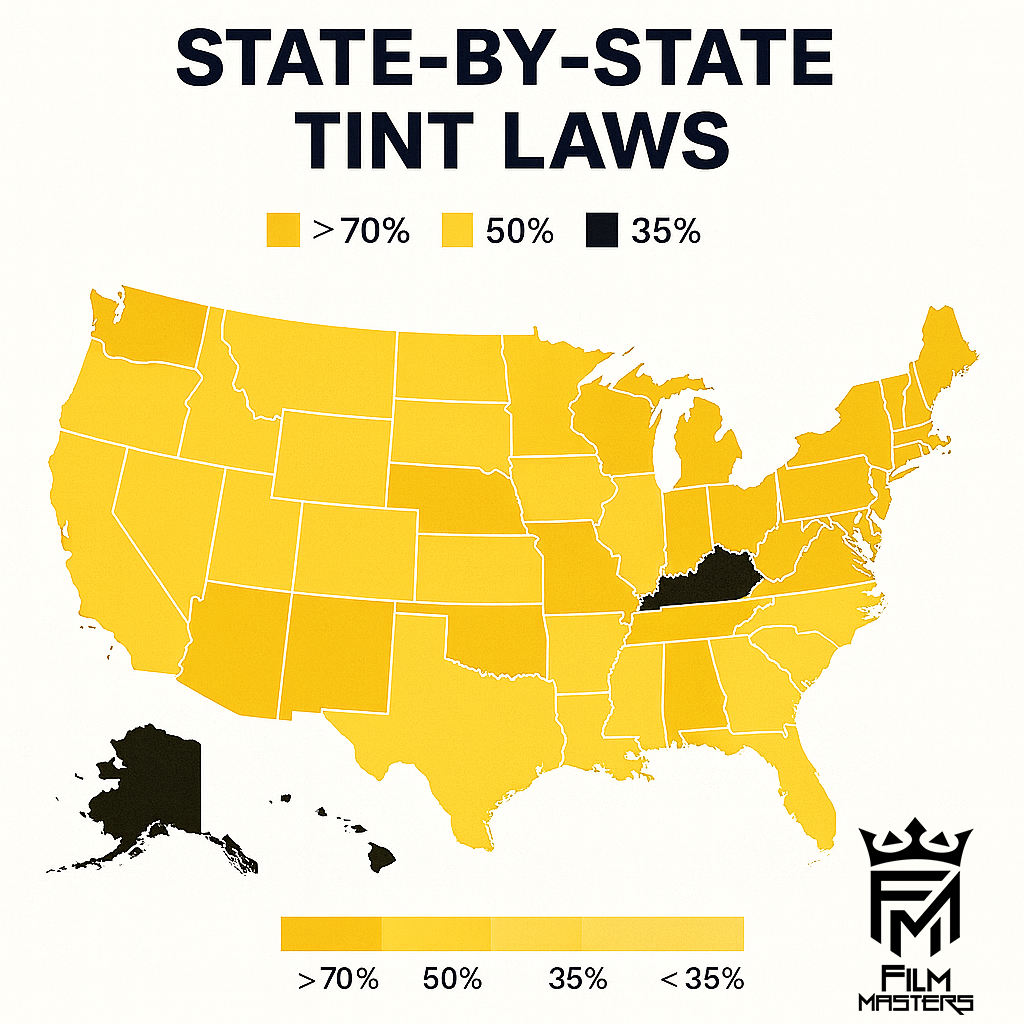Window tinting can dramatically improve comfort, reduce interior heat, block harmful UV rays, and enhance privacy. But there’s a catch: your tint must comply with state and local laws. Tint that’s too dark or too reflective can lead to fines, forced removal, or failed inspections.
In this guide, you’ll learn how tint laws work, what’s legal (and what’s not) in Florida and beyond, tips to stay compliant, and what to expect if you get pulled over.
Understanding tint laws starts with a few core concepts. Use these as your cheat sheet when reading “legal limits.”
| Term | What It Means | Why It Matters |
|---|---|---|
| VLT (Visible Light Transmission) | The percentage of visible light allowed through the tint + glass | Lower VLT = darker tint. Laws usually set a minimum VLT (i.e. you must allow at least X% light) |
| Reflectivity / Mirror Finish | How much light the tint reflects outward | Even if VLT limits are met, many states restrict how reflective your tint can be so as not to dazzle others |
| AS‑1 Line (Windshield) | A mark or region near the top of the windshield approved for tint | Most states only allow tinting above the AS‑1 line (i.e., the top “eyebrow”) |
| Medical Exemptions | Some states grant allowance for darker tinting when a driver or passenger has medical needs (e.g. light sensitivity) | Requires documentation, approval, and often a special certificate |
| Dual Side Mirrors Requirement | If your rear window is tinted darkly and restricts rear visibility, many states require you to have both left and right side mirrors | Helps law enforcement / other drivers see around your vehicle |
These rules aim to balance privacy, heat/UV protection, and safety / visibility.
Since you’re in Florida, here’s a detailed breakdown of what’s legal in Florida — and what you must watch out for.
Front Side Windows (Driver & Passenger): Must allow at least 28% VLT (i.e. no darker than 28%) Aaron’s Automotive Detailing+3Pro Tint of Orlando+3Tinting Laws+3
Back Side Windows & Rear Window:
Windshield: Tinting is allowed only above the manufacturer’s AS‑1 line, and only with non-reflective tint (under 25% reflectivity) Aaron’s Automotive Detailing+4Pro Tint of Orlando+4Tinting Laws+4
Reflectivity Limits:
Other Important Florida Rules:
Statutory Basis:
Penalty / Enforcement:
Violating Florida’s tint laws is treated as a noncriminal traffic infraction (i.e. a nonmoving violation) under Chapter 318 of Florida statutes, punishable by fines, potential removal orders, or mandatory correction. Florida Legislature
Recent Updates / Clarifications:

State-by-State Tint Laws (Overview / Highlights, Alphabetical by State)
Below is a sampling of state tint laws, organized alphabetically by state. (Note: this is a highlight set, not exhaustive; always verify with each state’s DMV or law enforcement for latest rules.)
| State | Front Side Windows VLT | Rear Side / Back Windows VLT | Rear Window | Windshield / Notes | Reflectivity / Other Restrictions |
|---|---|---|---|---|---|
| Alabama | 32% | 32% | 32% | Top 6 in. | Max 20% reflectivity Rayno Window Film+1 |
| Alaska | 70% | 40% | 40% | Top 5 in. | No metallic or mirrored tint; no red/yellow/amber Rayno Window Film+2Tint Wiz+2 |
| Arizona | 33% | Any | Any | Up to AS‑1 line | Max 35% reflective; red, amber not permitted; rear tint requires dual mirrors Rayno Window Film+1 |
| Arkansas | 25% | 25% | 10% | Top 5 in. | No mirrored/metallic tints Rayno Window Film+1 |
| California | 70% | Any | Any | Top 4 in. | Reflectivity no higher than standard window; no red/amber/blue tints; dual side mirrors for rear tint Rayno Window Film+1 |
| Colorado | 27% | 27% | 27% | Top 4 in. | No mirrored or metallic tints; red/amber prohibited; dual mirrors for rear windows Rayno Window Film+2TERMINAX+2 |
| Connecticut | 35% | 35% | Any | Non-reflective above AS‑1 | Max ~21% reflectivity; dual mirrors for rear tinted windows Rayno Window Film+1 |
| Delaware | 70% | Any | Any | Non-reflective above AS‑1 | No metallic / mirrored tint; dual mirrors for rear windows Rayno Window Film+2clearpro+2 |
| Florida | 28% | 15% (sedan) / 6% (SUV) | 15% (sedan) / 6% (SUV) | Above AS‑1 line only | Front reflectivity ≤25%, rear reflectivity ≤35%, no colored tints, dual mirrors needed Florida Legislature+4Tinting Laws+4Pro Tint of Orlando+4 |
| Georgia | 32% | 32% | 32% | Top 6 in. | Max 20% reflectivity; no red/amber tints Rayno Window Film+2Metro Restyling+2 |
| Hawaii | 35% | 35% | 35% | Must allow 70% light (windshield) | No mirrored or metallic tint; dual mirrors required Rayno Window Film+1 |
| Idaho | 35% | 20% | 35% | Up to AS‑1 line | Max 35% reflectivity; dual mirrors for rear windows Rayno Window Film+1 |
| Illinois | 35% | 35% | 35% | Top 6 in. | Non-reflective; dual mirrors required for rear tinting Rayno Window Film+1 |
| Indiana | 30% | 30% | 30% | Up to AS‑1 line | Max 25% reflective tinting Rayno Window Film+1 |
| Iowa | 70% | Any | Any | Up to AS‑1 line | No excessive reflectivity Rayno Window Film+2TERMINAX+2 |
| Kansas | 35% | 35% | 35% | Up to AS‑1 | No mirrored/metallic tint; no red/amber/yellow; dual mirrors for rear tinted windows Rayno Window Film+2TERMINAX+2 |
| Kentucky | 35% | 18% | 18% | Up to AS‑1 | Max 25% reflectivity Rayno Window Film+1 |
| Louisiana | 40% | 25% | 12% | Up to AS‑1 | Max 20% reflectivity Rayno Window Film+1 |
| Maine | 35% | Any | Any | Top 4 in. | Non-reflective tint only; dual mirrors required Rayno Window Film+1 |
| Maryland | 35% | 35% | 35% | Top 5 in. | No mirrored / metallic tints; no red/amber/yellow; dual mirrors required Rayno Window Film+1 |
| Massachusetts | 35% | 35% | 35% | Top 6 in. | Max 35% reflectivity; dual mirrors required for rear tinted windows Rayno Window Film |
| Michigan | 4‑inch limit (windshield strip) | Any | Any | Top 4 in. of windshield allowed | Max 35% reflectivity; no overall limit on side windows Rayno Window Film+2TERMINAX+2 |
| Minnesota | 50% | 50% | 50% | No tinting allowed on windshield | Max 20% reflectivity Rayno Window Film+1 |
| Mississippi | 28% | 28% | 28% | Up to AS‑1 | Max 20% reflectivity Rayno Window Film+1 |
| Missouri | 35% | Any | Any | Up to AS‑1 | Max 35% reflectivity; dual mirrors required for rear tinting Rayno Window Film+1 |
| Montana | 24% | 14% | 14% | Up to AS‑1 | Max 35% reflectivity Rayno Window Film+1 |
| Nebraska | 35% | 20% | 20% | Top 5 in. or AS‑1 line | Max 35% reflectivity; no red/amber tinting allowed Rayno Window Film |
| Nevada | 35% | Any | Any | Up to AS‑1 | Dual side mirrors required if rear tinted Rayno Window Film+1 |
| New Hampshire | None allowed on front side | 35% | 35% | Top 6 in. | No metallic / mirrored tints; dual mirrors required Rayno Window Film |
| New Jersey | None allowed on front side | Any | Any | No tinting allowed generally | No mirrored / metallic tints; dual mirrors required Rayno Window Film+1 |
| New Mexico | 20% | 20% | 20% | Top 5 in. or AS‑1 | Dual mirrors required for rear tinted windows Rayno Window Film+1 |
| New York | 70% | 70% | Any | Top 6 in. | No mirrored / metallic tints; dual mirrors required Rayno Window Film+2clearpro+2 |
| North Carolina | 35% | 35% | 35% | Up to AS‑1 line | Max 20% reflectivity; dual mirrors required; new law (Dec 2025) changes inspection of tint The Sun+2Rayno Window Film+2 |
| North Dakota | 50% | Any | Any | <70% | No mirrored / metallic tint; dual mirrors required Rayno Window Film |
| Ohio | 50% | Any | Any | Up to 70% reflectivity | Reflectivity limit to match standard windows Rayno Window Film+1 |
| Oklahoma | 25% | 25% | 25% | Top 5 in. or AS‑1 | Max 20% reflectivity; dual mirrors required for rear tinting Rayno Window Film+1 |
| Oregon | 35% | 35% | 35% | Top 6 in. | Max 13% reflectivity; no red/green/amber/black tints; dual mirrors required for rear windows Rayno Window Film+1 |
| Pennsylvania | 70% | 70% | 70% | No tinting allowed on windshield | No mirrored / metallic tints; dual mirrors required for rear windows Rayno Window Film+1 |
| Rhode Island | 70% | 70% | 70% | Up to AS‑1 | — Rayno Window Film |
| South Carolina | 27% | 27% | 27% | Up to AS‑1 | Non-reflective only; no red/amber tints; dual mirrors required Metro Restyling+1 |
| South Dakota | 35% | 20% | 20% | Up to AS‑1 | No mirrored / metallic tints Rayno Window Film |
| Tennessee | 35% | 35% | 20% | Up to AS‑1 | No mirrored / metallic tints Metro Restyling+1 |
| Texas | 25% | 25% | Any | Top 5 in. or AS‑1 | Max 25% reflectivity; no red/amber/blue tints; dual mirrors required Rayno Window Film+2clearpro+2 |
| Utah | 43% | Any | Any | Up to AS‑1 | No mirrored / metallic tint; dual mirrors required Rayno Window Film+1 |
| Vermont | None allowed | Any | 32% | Up to AS‑1 | No mirrored / metallic tint; dual mirrors required Rayno Window Film |
| Virginia | 50% | 35% | 35% | Up to AS‑1 | Max 20% reflectivity; no red/amber/yellow tint; dual mirrors required Rayno Window Film+1 |
| Washington | 24% | 24% | 24% | Top 6 in. | Max 35% reflectivity; no red/green/amber/black tints; dual mirrors required Rayno Window Film+1 |
| Washington, D.C. | 70% | 50% (cars) / 35% (multi‑purpose) | 50% / 35% | Top 5 in. or AS‑1 | — Rayno Window Film |
| West Virginia | 35% | 35% | 35% | Top 5 in. | Max 20% reflectivity; no red/amber tint; dual mirrors required Rayno Window Film |
| Wisconsin | 50% | 35% | 35% | Up to AS‑1 | — Rayno Window Film |
| Wyoming | 28% | 28% | 28% | Top 5 in. or AS‑1 | Max 20% reflectivity; dual mirrors required Rayno Window Film+1 |
Here are best practices to ensure your tint is legal (in Florida or any state you drive through):



